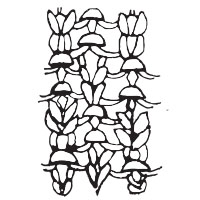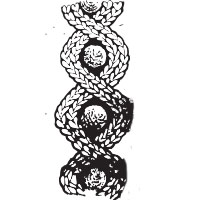History Of Aran
The people of Aran lived there for centuries and have made their living by the cultivation of the land, entailing really hard work as there is only a thin covering of soil over the rock surface and often no soil at all. Great use is made of seaweed to enrich and manure their crops; they also trade with the mainland in cattle swimming out and then being hauled aboard with ropes.
The island women weave their own tweed and make a type of belt called a “crios”, which is woven over the foot, in very bright colours and most attractive patterns.
Most knitting patterns were never written down, but handed on in families. The style of knitting is that known as Traditional. The highly skilled knitters turn out lovely work, but sometimes, with a true Irish touch of “nothing really matters” their knitting shows mistakes always found in the simple patterns, and a careless nonchalance in the crossing of their cables
The more intricate the pattern the more perfect the knitting, and their best work is of highest standards. Some of the interlaced or plaited patterns seen to have originated from the designs found on Irish stones and crosses – the latter are most impressive and rich in their decoration. These Aran knitters group their patterns very cleverly and use the travelling stitch, both plain and crossed, singly or in pairs and trebles, running across the surface of the knitting, and also use it in crossovers. Cable stitch is worked in with great effect among the other patterns. Some of the knitters embellish their work with “Bobbles” knitted in as the work progresses which certainly add a richness and character.
Handknitting
Hand knitting, like weaving, is a craft with roots deep in the life of the Irish Countryside. Hand knit “ganseys” or sweaters, caps, stockings, trousers and shawls were once commonly worn, but the Cottage industry of Irish Hand knits has lasted longest along the Western Seaboard. The hand knit sweaters of Donegal and Aran are world famous made of heavy oiled wool, guaranteed to keep out wind and weather, they are the traditional costume of the Fisherman. Equipped with the sweater, homespun Bawneen Trousers and Jackets, they braved the stormiest of seas in their currach’s. The knitters working for Erin will verify that it takes 40 hours of hand kitting to produce one garment.
Folklore
It was said that if a fisherman were drowned at sea and washed ashore far from home he might be identified by the stitches or pattern of his Gansey or other garment.
John Millington Synge who based some of his most famous plays on the stories he has heard, and the life he had experienced on the Aran Islands, describes in “Riders to the Sea” how a girl identifies the body of her drowned fisherman brother by the stockings he wore, “it’s the second one of the third pair I knitted, and I put up three score stitches and I dropped four of them.” In places like Aran and Donegal they will tell you that the stitches in a Gansey have meaning or tell a story relating to the life of the Fisherman – Sea, Earth, Sky, Marriage, Sons to take his place, many too, are supposed to have a religious significance.

Trinity of Blackberry
Is supposed to represent the Holy Trinity. It is done by making three stitches from one and one from three across the panel – hence its name

Double ZigZag
Depicting the ups and downs of married life (usually shown running from shoulder to hem of the garment) also represents forked lightning or cliff paths.

Ladder
Purl or twist stitches worked to form the poles and rungs of the ladder of life, against a plain stitch background. It symbolises the pilgrims road to eternal happiness.

Moss Stitch or Carrageen Moss
(Seaweed with medicinal properties – also used for making Blancmange)
It represents wealth to the Fisherfolk. Also called poor man’s wealth.

Link
The eternal link for those who left the island.

Trellis
An intricate pattern of plain stitches worked to form a trellis effect over purl stitches, represent the stony fields of the west, and the nets of the Fishermen.

Honeycomb
This looks like its name and is made by twisting stitches forwards and backwards across the panel. It is a tribute to the bee. It was considered a lucky omen if a fisherman saw a swarm of bees before setting out to sea a good catch was assured

Cable and Rope
Are of all types, and represent the Fisherman’s ropes.

Diamond
Usually formed in Moss Stitch is said to represent wealth and success.

Basket
The fisherman’s basket, for abundant catches.
